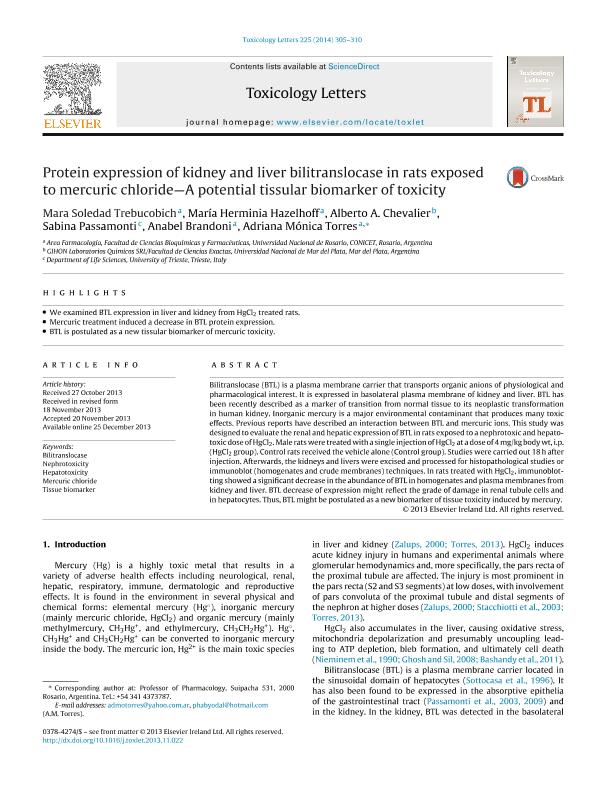Artículo
Protein expression of kidney and liver bilitranslocase in rats exposed to mercuric chloride—A potential tissular biomarker of toxicity
Trebucobich, Mara Soledad; Hazelhoff, Maria Herminia ; Chevalier, Alberto Antonio; Passamonti, Sabina; Brandoni, Anabel
; Chevalier, Alberto Antonio; Passamonti, Sabina; Brandoni, Anabel ; Torres, Adriana Monica
; Torres, Adriana Monica
 ; Chevalier, Alberto Antonio; Passamonti, Sabina; Brandoni, Anabel
; Chevalier, Alberto Antonio; Passamonti, Sabina; Brandoni, Anabel ; Torres, Adriana Monica
; Torres, Adriana Monica
Fecha de publicación:
01/2014
Editorial:
Elsevier Ireland
Revista:
Toxicology Letters
ISSN:
0378-4274
Idioma:
Inglés
Tipo de recurso:
Artículo publicado
Clasificación temática:
Resumen
Bilitranslocase (BTL) is a plasma membrane carrier that transports organic anions of physiological and pharmacological interest. It is expressed in basolateral plasma membrane of kidney and liver. BTL has been recently described as a marker of transition from normal tissue to its neoplastic transformation in human kidney. Inorganic mercury is a major environmental contaminant that produces many toxic effects. Previous reports have described an interaction between BTL and mercuric ions. This study was designed to evaluate the renal and hepatic expression of BTL in rats exposed to a nephrotoxic and hepatotoxic dose of HgCl2. Male rats were treated with a single injection of HgCl2 at a dose of 4 mg/kg body wt, i.p. (HgCl2 group). Control rats received the vehicle alone (Control group). Studies were carried out 18 h after injection. Afterwards, the kidneys and livers were excised and processed for histopathological studies or immunoblot (homogenates and crude membranes) techniques. In rats treated with HgCl2, immunoblotting showed a significant decrease in the abundance of BTL in homogenates and plasma membranes from kidney and liver. BTL decrease of expression might reflect the grade of damage in renal tubule cells and in hepatocytes. Thus, BTL might be postulated as a new biomarker of tissue toxicity induced by mercury
Archivos asociados
Licencia
Identificadores
Colecciones
Articulos(CCT - ROSARIO)
Articulos de CTRO.CIENTIFICO TECNOL.CONICET - ROSARIO
Articulos de CTRO.CIENTIFICO TECNOL.CONICET - ROSARIO
Citación
Trebucobich, Mara Soledad; Hazelhoff, Maria Herminia; Chevalier, Alberto Antonio; Passamonti, Sabina; Brandoni, Anabel; et al.; Protein expression of kidney and liver bilitranslocase in rats exposed to mercuric chloride—A potential tissular biomarker of toxicity; Elsevier Ireland; Toxicology Letters; 225; 2; 1-2014; 305-310
Compartir
Altmétricas



